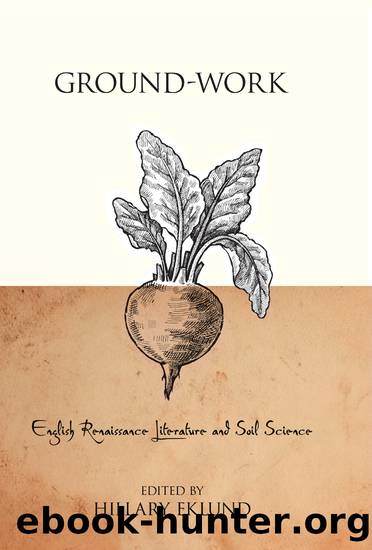Ground-Work by Hillary Eklund;

Author:Hillary Eklund;
Language: eng
Format: epub
Tags: English literature—Early modern, 1500–1700—History and criticism, Nature in literature, Soil and civilization, Ecocriticism, Literature and science—England—History—16th century, Literature and science—England—History—17th century
Publisher: Pennsylvania State University Press
HOMOGENIZING THE WORLD
Drainage projects in England were not isolated public works initiatives but instead part of a more widespread tendency among European powers to make the natural unknowns of the world both known and controlled. In France, for instance, inland lakes were drained as projectors sought to manufacture land for arable and animal husbandry and for housing.18 European involvement in New World reclamation projects dates back to the settlement of Mexico City, where Dutch engineers undertook drainage projects as early as 1614.19 In these and other locales, drainage was a crucial thread in knitting the fabric of human prepotency over cyclical changes in the natural world. As such, it formed part of what Shakespeare scholar Garrett Sullivan terms âthe landscape of sovereignty,â which âreflects and shapes the ambitions and imperatives of those who control or would control the kingdom; and, more broadly but distinctly . . . represents the conceptual annexation of distinct cultural spaces in the name of monarch or (a culturally homogenized) nation.â20 By imposing a homogenized, official landscape onto what literary critic and environmental theorist Rob Nixon has called a âvernacular landscape,â colonizers, chorographers, and drainage promoters threatened the lives of local inhabitants as well as patterns of living that integrated cultural and environmental knowledge and practices â a soil science of the swamp.21
As an economic response to new ecological information, the âofficial landscapeâ or âlandscape of sovereigntyâ traffics in a mixture of desire (for profitable land) and disgust inflected by ecophobia, a term the Shakespearean eco-critic Simon Estok uses to describe âan irrational and groundless fear or hatred of the natural worldâ that often appears in an early modern tendency to âimagin[e] badness in nature and [market] that imagination.â22 (Here we need only think of the sinful Slough of Despond in John Bunyanâs Pilgrimâs Progress [1678], the swamp into which Christian sinks under the weight of his sin.23) In Shakespeareâs Tempest, for instance, the shipwrecked nobles disagree about the climate of the island: where Antonio and Sebastian complain that the air is rotten, âas âtwere perfumed by a fenâ (2.1.48â49), Gonzalo and Adrian praise the qualities of the isle.24 Similarly, both before and after the establishment of Jamestown on the fertile floodplains of the Tidewater, explorers in Virginia construed the land as an empty waste even as they praised the fecundity of the soil. In his Generali Historie of Virginia, New England, and the Somer Isles (1624), Captain John Smith derides unfavorable reports of the swamps of coastal Virginia as âvulgar rumour,â which attributes the colonyâs troubles âto the vnwholesomnesse of the ayre, and barrennesse of the Country, as though all England were naught, because the Fens and Marshes are vnhealthy.â25 In drawing a direct comparison between colonial and domestic attitudes toward wetlands, Smith opens the channel through which modern plantation strategies that had been developed in the New World may have driven higher-stakes improvement projects in England. Indeed, as new landscapes were domesticated, they might even look better than those closer to home: âsome small
Download
This site does not store any files on its server. We only index and link to content provided by other sites. Please contact the content providers to delete copyright contents if any and email us, we'll remove relevant links or contents immediately.
The Power of Myth by Joseph Campbell & Bill Moyers(1006)
Half Moon Bay by Jonathan Kellerman & Jesse Kellerman(953)
A Social History of the Media by Peter Burke & Peter Burke(936)
Inseparable by Emma Donoghue(926)
The Nets of Modernism: Henry James, Virginia Woolf, James Joyce, and Sigmund Freud by Maud Ellmann(834)
The Spike by Mark Humphries;(765)
The Complete Correspondence 1928-1940 by Theodor W. Adorno & Walter Benjamin(746)
A Theory of Narrative Drawing by Simon Grennan(742)
Culture by Terry Eagleton(717)
Ideology by Eagleton Terry;(696)
Bodies from the Library 3 by Tony Medawar(680)
World Philology by(675)
Farnsworth's Classical English Rhetoric by Ward Farnsworth(673)
Game of Thrones and Philosophy by William Irwin(669)
High Albania by M. Edith Durham(657)
Adam Smith by Jonathan Conlin(648)
A Reader’s Companion to J. D. Salinger’s The Catcher in the Rye by Peter Beidler(646)
Comic Genius: Portraits of Funny People by(616)
Monkey King by Wu Cheng'en(609)
